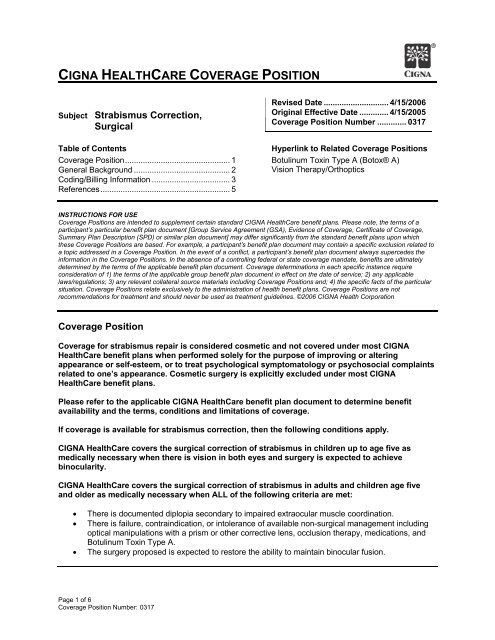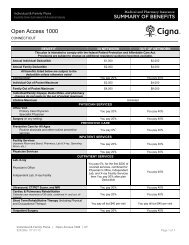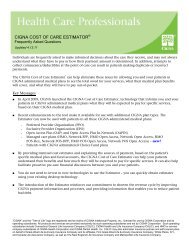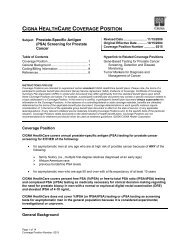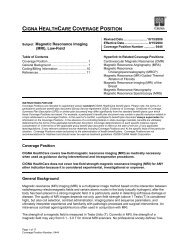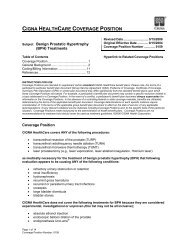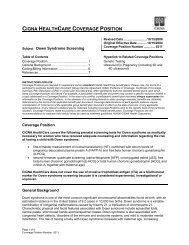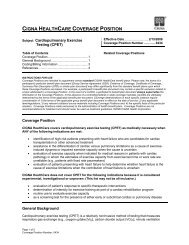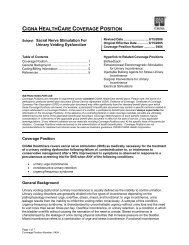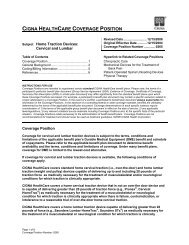Strabismus Correction, Surgical
Strabismus Correction, Surgical
Strabismus Correction, Surgical
You also want an ePaper? Increase the reach of your titles
YUMPU automatically turns print PDFs into web optimized ePapers that Google loves.
CIGNA HEALTHCARE COVERAGE POSITIONSubject <strong>Strabismus</strong> <strong>Correction</strong>,<strong>Surgical</strong>Table of ContentsCoverage Position............................................... 1General Background ........................................... 2Coding/Billing Information ................................... 3References.......................................................... 5Revised Date ............................. 4/15/2006Original Effective Date ............. 4/15/2005Coverage Position Number ............. 0317Hyperlink to Related Coverage PositionsBotulinum Toxin Type A (Botox® A)Vision Therapy/OrthopticsINSTRUCTIONS FOR USECoverage Positions are intended to supplement certain standard CIGNA HealthCare benefit plans. Please note, the terms of aparticipant’s particular benefit plan document [Group Service Agreement (GSA), Evidence of Coverage, Certificate of Coverage,Summary Plan Description (SPD) or similar plan document] may differ significantly from the standard benefit plans upon whichthese Coverage Positions are based. For example, a participant’s benefit plan document may contain a specific exclusion related toa topic addressed in a Coverage Position. In the event of a conflict, a participant’s benefit plan document always supercedes theinformation in the Coverage Positions. In the absence of a controlling federal or state coverage mandate, benefits are ultimatelydetermined by the terms of the applicable benefit plan document. Coverage determinations in each specific instance requireconsideration of 1) the terms of the applicable group benefit plan document in effect on the date of service; 2) any applicablelaws/regulations; 3) any relevant collateral source materials including Coverage Positions and; 4) the specific facts of the particularsituation. Coverage Positions relate exclusively to the administration of health benefit plans. Coverage Positions are notrecommendations for treatment and should never be used as treatment guidelines. ©2006 CIGNA Health CorporationCoverage PositionCoverage for strabismus repair is considered cosmetic and not covered under most CIGNAHealthCare benefit plans when performed solely for the purpose of improving or alteringappearance or self-esteem, or to treat psychological symptomatology or psychosocial complaintsrelated to one’s appearance. Cosmetic surgery is explicitly excluded under most CIGNAHealthCare benefit plans.Please refer to the applicable CIGNA HealthCare benefit plan document to determine benefitavailability and the terms, conditions and limitations of coverage.If coverage is available for strabismus correction, then the following conditions apply.CIGNA HealthCare covers the surgical correction of strabismus in children up to age five asmedically necessary when there is vision in both eyes and surgery is expected to achievebinocularity.CIGNA HealthCare covers the surgical correction of strabismus in adults and children age fiveand older as medically necessary when ALL of the following criteria are met:• There is documented diplopia secondary to impaired extraocular muscle coordination.• There is failure, contraindication, or intolerance of available non-surgical management includingoptical manipulations with a prism or other corrective lens, occlusion therapy, medications, andBotulinum Toxin Type A.• The surgery proposed is expected to restore the ability to maintain binocular fusion.Page 1 of 6Coverage Position Number: 0317
General Background<strong>Strabismus</strong> refers to ocular misalignment as a result of impaired extraocular muscle coordination. It is oneof the most common eye disorders in children, affecting approximately 3% of the general population. Riskfactors for strabismus include prematurity, family history, cerebral palsy, many chromosomal and othermajor genetic abnormalities, and major head trauma. Strabismic disorders are characterized by theinward, outward or vertical deviation of one or both eyes. This deviation causes the two eyes to bedirected to different points when viewing the same object, making it difficult to maintain binocularity.Binocular vision allows for the perceptions of depth and dimension. Normal binocular vision depends onsensory fusion or integration of information from both eyes, as well as motor alignment and eyecoordination. <strong>Strabismus</strong> may result in impaired depth perception, amblyopia, diplopia, suppression ofvision of one eye, or an undesirable appearance. The two most common strabismic conditions areesotropia (eye turns inward) and exotropia (eye turns outward).The classification of strabismus may be based on a number of factors in addition to the relative position ofthe eyes. These factors include age of onset, degree of associated refractive error, and whether thedeviation is concomitant (constant), or incomitant (intermittent). Infantile strabismus, also referred to ascongenital esotropia, usually occurs before six months of age. Acquired strabismus may occur at any timeafter infancy but is frequently associated with adult onset of the disorder. Adult strabismus includes alltypes of congenital and acquired strabismus that have persisted in individuals beyond the age of nine,which is considered the age of visual maturity. The type of strabismus is established by a detailed historyand ophthalmoscopic examination.The U.S. Preventive Services Task Force (USPTF) specifically recommends screening to detectamblyopia, strabismus and defects in visual acuity in children younger than five years of age. TheAmerican Academy of Pediatrics (AAP) recommends that all children have an assessment for eyeproblems in the newborn period and then at all subsequent routine health visits. Infants and children athigh risk for eye problems should be referred to a pediatric ophthalmologist for specialized examination.Timely diagnosis and appropriate treatment of children with strabismus is likely to reduce the prevalenceof persistent amblyopia and ocular misalignment in adults (Royal College of Ophthalmologists, 2000).The treatment goals for acquired and congenital strabismus are usually to restore the ability to maintainsingle binocular vision and fusion of images and to improve impaired depth perception. Interventions forthe treatment of strabismus include: surgery, botulinum toxin A injection, occlusion therapy, miotic andmydriotic medications, and optical manipulations with a prism or other corrective glasses. <strong>Surgical</strong>procedures involve lengthening or shortening the extraocular muscles to realign the affected eye. <strong>Surgical</strong>intervention is indicated for most cases of esotropia and exotropia in children, but should be performedonly when more conservative methods are ineffective.Simonsz and colleagues (2005) compared the outcomes of early versus late surgery for infantilestrabismus in a prospective, controlled, non-randomized, multicenter trial. A total of 200 children hadsurgery early (i.e., age 6-24 months) and 232 children were scheduled for late surgery (i.e., age 32-60months). Primary outcome measures included level of binocular vision, angle of strabismus at distanceand visual acuity. Final follow-up examinations were performed at an average age of 6.8 years in the bothgroups. Binocular vision at final examination was significantly better in the early group than in the lategroup (p=0.001). The angle of strabismus was not found to be different between the two treatment groups(p=0.967). The ratio of visual acuities (i.e., worse eye relative to better eye) was larger in the early groupthan in the late group (p=0.023). Based on the larger proportion of children in the early group who had anincreased level of binocular vision, the investigators concluded that early surgery for large-angle esotropiaseems warranted.Adults may have strabismus beginning in childhood or may have acquired the disorder due to cranialnerve palsies, trauma or neurological conditions. Unlike children with strabismus, adults may have hadnormal binocularity prior to the onset of strabismus and, as a result, may have diplopia and visualconfusion. The initial symptoms of strabismus in adults may include: abnormal head posture, headache,eye fatigue or pain. In adults with untreated congenital strabismus, it may be too late to treat theassociated amblyopia and depth perception impairment; therefore, the goal of treatment is sometimespurely cosmetic.Page 2 of 6Coverage Position Number: 0317
Note: This list of codes may not be all-inclusive.Covered when medically necessary:CPT ® * DescriptionCodes67311 <strong>Strabismus</strong> surgery, recession or resection procedure; one horizontal muscle67312 <strong>Strabismus</strong> surgery, recession or resection procedure; two horizontal muscles67314 <strong>Strabismus</strong> surgery, one vertical muscle (excluding superior oblique)67316 <strong>Strabismus</strong> surgery, two or more vertical muscles (excluding superior oblique)67318 <strong>Strabismus</strong> surgery, any procedure, superior oblique muscle67320 Transposition procedure (e.g., for paretic extraocular muscle), any extraocularmuscle67331 <strong>Strabismus</strong> surgery on patient with previous eye surgery or injury that did notinvolve the extraocular muscles67332 <strong>Strabismus</strong> surgery on patient with scarring of extraocular muscles (eg, priorocular injury, strabismus or retinal detachment surgery) or restrictive myopathy(eg, dysthyroid ophthalmopathy)67334 <strong>Strabismus</strong> surgery by posterior fixation suture technique, with or without musclerecession67335 Placement of adjustable suture(s) during strabismus surgery, includingpostoperative adjustment(s) of suture(s)67340 <strong>Strabismus</strong> surgery involving exploration and/or repair of detached extraocularmuscle(s)HCPCSCodesNo specificcodesDescriptionICD-9-CM DescriptionDiagnosisCodes378.00 – Esotropia378.08378.10 – Exotropia378.18378.20 – Intermittent heterotropia378.24378.30 – Other and unspecified heterotropia378.34378.40 – Heterophoria378.45378.50 – Paralytic strabismus378.54378.60 – Mechanical strabismus378.62378.71 – Other specified strabismus378.73378.81 – Other disorders of binocular eye movements378.87378.9 Unspecified disorders of eye movements*Current Procedural Terminology (CPT ® ) © 2005 American Medical Association: Chicago, IL.Page 4 of 6Coverage Position Number: 0317
References1. American Association for Pediatric Ophthalmology and <strong>Strabismus</strong> (AAPOS) and the AmericanAcademy of Ophthalmology (AAO). Joint policy statement: adult strabismus surgery. AAPOSapproved2001 Mar; AAO-approved 2002 Apr. Accessed Feb 25, 2005. Available at URLaddress: http://www.aao.org/aao/member/policy/adult.cfm2. Bateman JB, Christmann LM, Dankner SR, Drack AV, Handler SM, Tychsen L, et al. (PediatricOphthalmology Panel). Preferred practice pattern: esotropia and exotropia. San Francisco, CA:American Academy of Ophthalmology; 2002 Oct. Accessed Feb 25, 2005. Available at URLaddress:http://www.aao.org/education/library/ppp/loader.cfm?url=/commonspot/security/getfile.cfm&PageID=12803. Beauchamp GR, Black BC, Coats DK, Enzenauer RW, Hutchinson AK, Saunders RA, et al. Themanagement of strabismus in adults--I. Clinical characteristics and treatment. J AAPOS. 2003Aug;7(4):233-40.4. Beauchamp GR, Black BC, Coats DK, Enzenauer RW, Hutchinson AK, Saunders RA, et al. Themanagement of strabismus in adults--II. Patient and provider perspectives on the severity of adultstrabismus and on outcome contributors. J AAPOS. 2005 Apr;9(2):141-7.5. Beauchamp GR, Black BC, Coats DK, Enzenauer RW, Hutchinson AK, Saunders RA, et al. Themanagement of strabismus in adults--III. The effects on disability. J AAPOS. 2005 Oct;9(5):455-9.6. Gill MK, Drummond GT. Indications and outcomes of strabismus repair in visually maturepatients. Can J Ophthalmol. 1997;32(7):436-40.7. Ludwig IH, Brown MS. Flap tear of rectus muscles: an underlying cause of strabismus after orbitaltrauma. Ophthal Plast Reconstr Surg. 2002;18(6):443-9; discussion 450.8. Mets MB, Beauchamp C, Haldi BA. Binocularity following surgical correction of strabismus inadults. J AAPOS. 2004 Oct;8(5):435-8.9. Mills MD, Coats DK, Donahue SP, Wheeler DT; American Academy of Ophthalmology (AAO).<strong>Strabismus</strong> surgery for adults: a report by the American Academy of Ophthalmology.Ophthalmology. 2004 Jun;111(6):1255-62.10. Mocan MC, Azar N. <strong>Surgical</strong> timing for infantile esotropia. Int Ophthalmol Clin. 2005 Fall;45(4):83-95.11. National Eye Institute (NEI). Clinical Studies Database. An Evaluation Of Treatment Of AmblyopiaIn Children 7 To
15. Rustein RP. Care of the patient with strabismus: exotropia and esotropia. St. Louis, MO:American Consensus Panel on Care of the Patient With <strong>Strabismus</strong>; 1995. p. 26-41.16. Simonsz HJ, Kolling GH, Unnebrink K. Final report of the early vs. late infantile strabismussurgery study (ELISSS), a controlled, prospective, multicenter study. <strong>Strabismus</strong>. 2005Dec;13(4):169-99.17. Ticho BH. <strong>Strabismus</strong>. Pediatr Clin North Am. 2003 Feb;50(1):173-88.18. U.S. Preventive Services Task Force (USPTF). Screening for visual impairment in childrenyounger than five years: recommendation statement. Am Fam Physician. 2005 Jan 15;71(2):333-6.19. Williams C, Harrad R. Amblyopia: contemporary clinical issues. <strong>Strabismus</strong>. 2006 Mar;14(1):43-50.20. Yanoff M, Duker JS, editors. Ophthalmology. 2nd ed. St. Louis, MO: Mosby, Inc.; 2004.21. Yazdani A, Traboulsi EI. Classification and surgical management of patients with familial andsporadic forms of congenital fibrosis of the extraocular muscles. Ophthalmology.2004;111(5):1035-42.Page 6 of 6Coverage Position Number: 0317


